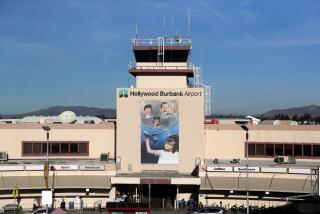Burbank Airport Considers Noise Reduction Plan
- Share via
BURBANK — One day, the theory goes, homeowners living under Burbank Airport’s flight path may stand outdoors and see a large commercial jet fly overhead, but hear no more noise than that made by a passing car.
Microphones and loudspeakers with computer chips would identify the aircraft’s noise frequencies and transmit signals at the speed of light to a computer at the Burbank Airport, which would then send back signals to produce counter-sound waves, instantly canceling the plane’s roar.
Although it is unclear when--or if--this untried noise-cancellation theory could work in a large residential area, a proposal to pay UCLA researchers up to $2.1 million over the next four years to look into the technology will come before the Burbank-Glendale-Pasadena Airport Authority on Monday.
“If it works out,” said Carl W. Raggio Jr., interim president for the airport’s nine-member board of commissioners, “it will solve a lot of problems. Right now, it has a lot of promise. We’re willing to invest in that promise.”
Noise cancellation is hailed by some as perhaps the best way to relieve the ears of nearby residents, but considered an impractical solution by some experts.
If successful, the project could substantially improve the quality of life for thousands of people in the southeast San Fernando Valley who are forced to shut their windows, wake up early or halt telephone conversations because of aircraft noise.
The proposed project would involve using microphones, loudspeakers and computer chips that could be installed in a room of a house or on a front lawn to reduce noise levels by as much as 25 decibels instantly, proponents contend.
The head of the UCLA team, engineering professor Chih-Ming Ho, declined to discuss the proposal before his presentation to airport commissioners on Monday.
But according to their report, researchers believe their greatest challenge will be to create a system that can drown out aircraft noise but not sounds from other sources, such as a television set.
All noises are carried by sound waves that rise and fall. Counter-waves, falling and rising on the opposite frequencies, can reduce or eliminate the level of audible sound.
Because the sound signals would travel instantly to and from a computer at the airport, the canceling effect could take place as quickly as the sound was heard, Raggio said.
Although sound cancellation has been shown to be feasible with small, headphone-equipped units, experts in engineering and acoustics say that an obvious problem with the proposed project would be using the equipment in such a large application.
The farther away a person was from a loudspeaker, for example, the less noise-cancellation effect there would be, increasing the likelihood that a neighbor who lacked such equipment would hear twice as much noise when a plane passed overhead--the sound of the plane plus the blast of counter-sound from his neighbor’s house.
“I would be reluctant to do it in my house,” said Robert Smith, director of the Institute for Sensory Research at Syracuse University.
“I’m not saying it wouldn’t work,” he said. “The thing is, when you create a cancellation, great. The question is, what happens if you’re slightly off balance? What’s left . . . could be a problem in and of itself.”
Noise cancellation, said USC electrical engineering professor Eberhardt Rechtin, “is known to work when someone wants to go to sleep and put headphones on.”
“But,” he added, “taking the headphones off and replacing them with a pair of speakers, the technical problem is, how much coverage can you get? With enough speakers and microphones, I suppose you could do it, but it would be hideously expensive.”
UCLA researchers say the noise-cancellation equipment they envision would cost a few thousand dollars per household, according to a report outlining the project. Who would pay for it has not been determined, airport officials say.
A spokeswoman for Los Angeles International Airport--the fifth busiest airport in the world--said her facility would consider it if Burbank Airport is successful.
The impact of aircraft noise was a key issue during this year’s municipal elections, resulting in a new majority on the Burbank City Council that opposes plans to expand the airport’s operations.
Raggio said he first approached UCLA’s experts last fall looking for ways to mitigate noise beyond the traditional practice of soundproofing, which involves insulating the interior of a home or school and adding two panes of glass to windows, among other things.
With funding from the Federal Aviation Administration, airport officials have helped soundproof one nearby school, are working on three others, and may do the same with 12 residential homes. But soundproofing can be expensive--as much as $40,000 for a single house.
The noise-cancellation project, said Dick Dyer, who advises airports statewide on noise issues, “requires technology that has not yet been proven to exist in airport situations. Personally, I think it’s a difficult task.”
More to Read
Sign up for Essential California
The most important California stories and recommendations in your inbox every morning.
You may occasionally receive promotional content from the Los Angeles Times.













